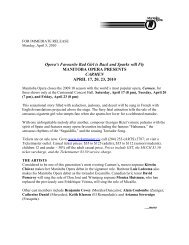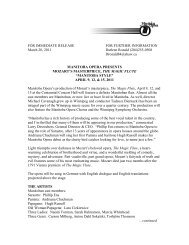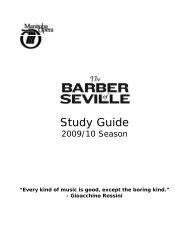La Traviata Study Guide - Manitoba Opera
La Traviata Study Guide - Manitoba Opera
La Traviata Study Guide - Manitoba Opera
You also want an ePaper? Increase the reach of your titles
YUMPU automatically turns print PDFs into web optimized ePapers that Google loves.
Workshop 2– Stage Business<br />
Objectives: Students will be able to express and apply their knowledge of the areas of the stage<br />
through writing and movement. Students will investigate the historical background of stage<br />
positioning.<br />
Pre-class: Tape a massive grid to the floor of the space you are working in. This can be used to<br />
physically point out the areas of the stage as well as be used for the game (“Director Says”).<br />
Activity #1: Group Discussion<br />
Have a group discussion with your class regarding why individuals might need to assign names<br />
for the different areas of the theatre, questioning the purpose that it serves.<br />
Activity #2: Historical Significance of the Stage<br />
Explain briefly the historical significance for the set-up of the theatre. Include such points as<br />
how the stage was originally raked so that the back portion of the stage was higher than the front<br />
portion. This was done because the audience’s seats were not raised as they usually are today. It<br />
enabled those individuals sitting in the back row of the theatre to see the players clearly. As a<br />
result the back of the stage is called up stage and the front of the stage is referred to as down<br />
stage.<br />
You may also choose to discuss which areas of the stage are most important. For example, the<br />
strongest entrance is from stage left.<br />
Distribute the “Stage Facts” on the next page, so that students can refer to it as you physically go<br />
to the taped area that you are explaining. You may choose to have them draw and copy the areas<br />
of the stage for themselves.<br />
Activity #3: “Director Says” Game<br />
The teacher designates one of the students as the director, or for the first round you can be the<br />
director. The remaining students are the performers.<br />
The director gives out the directions: “Move upstage”, “Move stage right,” “Move to up centre,”<br />
etc. The director may give out directions to the entire group at once, small groups, or individuals<br />
e.g.: “All performers with red socks go to stage left.”<br />
Students are out if they move in any direction other than the one the director gives. The director<br />
gives out directions more rapidly, and any performer who moves in the wrong direction or<br />
hesitates is out. You may need to have a judge.<br />
Stage Facts<br />
<strong>Opera</strong> singers are required to act as well as sing and therefore they must understand the stage setup.<br />
In rehearsals, the director will indicate to the singers what they should be doing and where<br />
they should do it. To do this they use a special vocabulary. Take a look at the diagram below in<br />
order to understand the different areas of the stage.<br />
23








